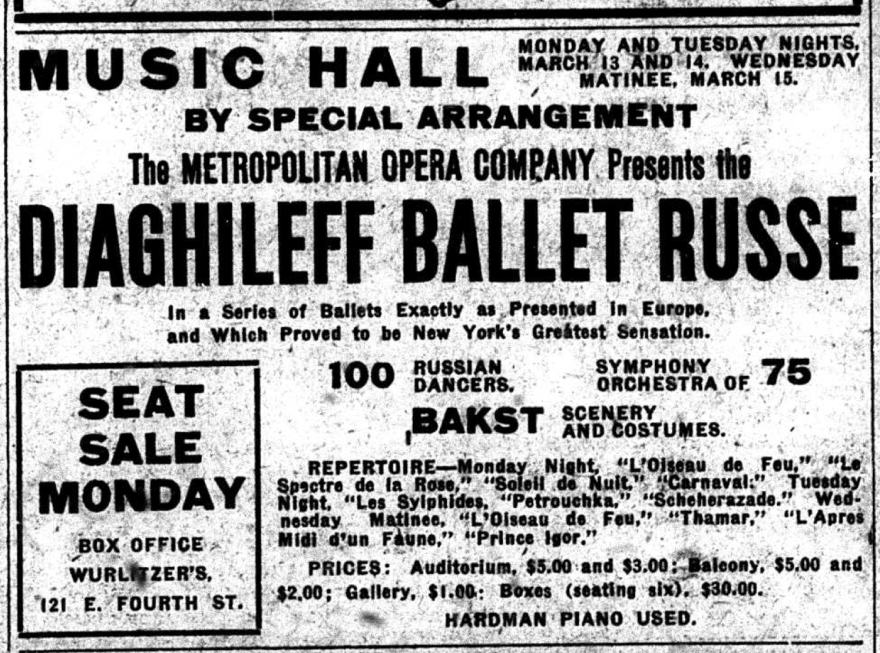When you hear “Russian ballet,” Dayton, Ohio probably isn’t the first thing that comes to mind. But on February 8, 1917, the Ballets Russes, a radical Russian dance company based in Paris, performed at the Victoria Theater. That was twenty years before Dayton had its own ballet company. Listener Sandra Harewood learned about the performance and asked WYSO Curious to investigate.
What was the Ballets Russes?
The Ballets Russes was avant-garde in Europe. Its director, Sergei Diaghilev, made a point of commissioning new music from up-and-coming composers like Stravinsky and Rimsky-Korsakov, set designs from artists like Picasso and Matisse, and costume designs from Coco Chanel, among others. It wasn’t without scandal either—when the company premiered The Rite of Spring in 1913, there were riots in the audience.
What were they doing in Dayton?
Sam Dorf is a professor of musicology at the University of Dayton. He looked through hundreds of programs and newspaper clippings from the company’s time in America. Dorf says the Ballets Russes mounted an American tour from 1916 through 1917 to escape World War I in Europe. “Let’s be honest,” he says, “It’s not easy to have a ballet company while the continent is at war.”

The first year of the tour stopped in 17 places—mostly large cities like New York, Chicago, and Cincinnati. However, the second year of the tour included 55 smaller towns like Dayton, which hadn’t seen them yet.
Getting to all these cities meant a grueling schedule for the company. Dorf explains that “They’d set everything up, do one or two shows, then pack everything up, get on a train, and go to another city.”
By the time they’d reached Dayton, morale was low. The dancers were exhausted, and running out of money.
“There are these very sad letters from some of these European dancers writing to their mothers,” Dorf says, “saying ‘Diaghilev hasn’t paid us in a while, we’re staying in these questionable hotels, can you send money?’”
“Not without its appeal and its compensations”

We don’t know much about what the Ballets Russes thought of Dayton, but we do know a bit about what Dayton, or at least the Dayton press, thought of them. At the time, the city didn’t have its own orchestra, and the Dayton Ballet wasn’t founded until 1937, twenty years later. Visits from Europe would have been quite rare, but, surprisingly, the performance was a box-office flop; the Victoria Theater was only about half-full.
The audience that did show up was largely disappointed, since the press had over-hyped the performance. Local newspapers floated names of composers like Stravinsky, and controversial new ballets like Scheherazade, which weren’t on the program.
They also promised an appearance from Vasilav Nijinsky, a celebrity dancer who was traveling with the company as their tour director, but not as a performer. In an attempt to create interest about Nijinsky, papers had even printed a story about the dancer’s visit to a college football practice.
The Dayton Daily News tried to be diplomatic in its review the next day. “All in all,” the paper reported, “This Nijinsky-less performance was not without its appeal and its compensations.”
“They’d never heard anything like this”
Daytonians weren’t wild about the dancing, but the music really caught on. In Dayton, the Ballets Russes performed Papillon, Cleopatre, and Thamar, pieces by French and Russian composers.
At the time, most orchestras in the Midwest were dominated by German musicians, so concertgoers heard mostly German repertoire, such as Beethoven and Brahms. About Russian and French music, Dorf says, “In Dayton, they’d never heard anything like this.”

His research also showed that after the 1917 performance, people in Dayton could hear a traveling orchestra perform French or Russian music at least once a year.
The Ballet Russes performance changed the kind of music people in Dayton got to listen to. But Dorf says that part of the magic of their performance is it can never be recreated.
“What’s really interesting about ballet history,” he says, “Is that it exists in memory, and in bodies that die. But it’s exciting to find, in our own community, these spaces where these bodies danced."
Learn more:
See Ballets Russes costumes here.
Hear more music from Papillon here,
and Thamar here.
WYSO Curious is our occasional series about your questions and curiosities—let us know what you are curious about in the Miami Valley, and your question could get answered by a WYSO reporter. WYSO Curious is a partnership with Hearken, founded by Jennifer Brandel based on her work at Curious City/WBEZ Chicago.
_





